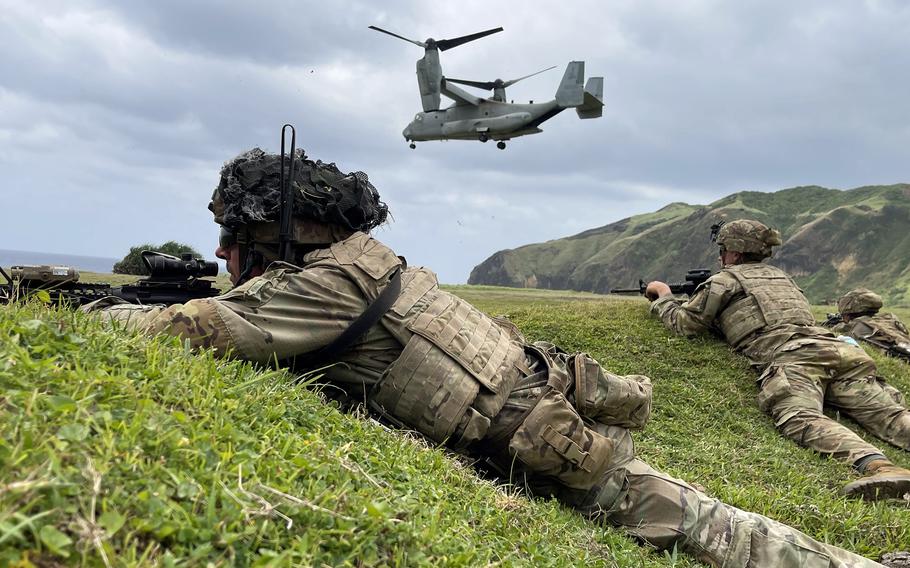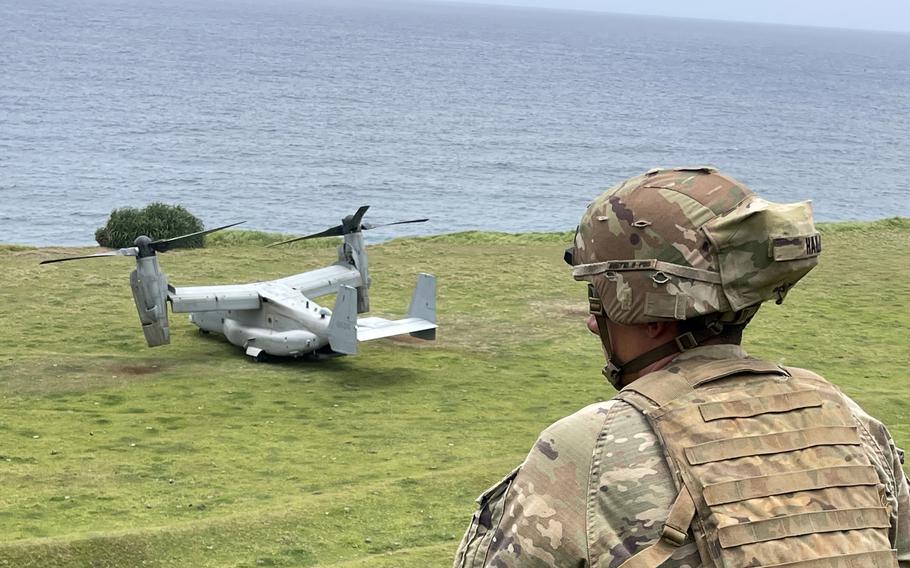
U.S. troops take part in amphibious air assault training on Batan Island, Philippines, April 23, 2023. (Jeffrey Tolbert/U.S. Army)
American and Filipino troops may train again on islands facing Taiwan in the Luzon Strait, a likely arena in the event of conflict with China, according to a Philippine newspaper.
U.S. soldiers and Marines and Filipino troops air assaulted onto the islands of Fuga, Calayan and Batan last April during the largest-ever annual Balikatan exercise.
Lt. Gen. Fernyl Buca, of the Philippine military’s Northern Luzon Command, visited Batan and Mavulis, the country’s northernmost point, over the weekend, the Philippine Inquirer reported Tuesday. He was joined by planners for this spring’s Balikatan, which means “shoulder to shoulder” in Tagalog.
“It’s for advance planning for a possible proposed exercise area in future Balikatan (drills),” the general told the newspaper.
Amid fears of a Chinese invasion or blockade of Taiwan, the U.S. military has been upgrading Philippine bases that its forces may use under a 2014 agreement with the longtime ally.
Meanwhile, the Philippines and China have been at odds over disputed territory in the South China Sea.
“The waterway separating the northern Philippines from Taiwan, the Luzon Strait and Bashi Channel, will play a strategic role in any Taiwan conflict between China and the United States,” according to Carlyle Thayer, an emeritus professor at the University of New South Wales and a lecturer at the Australian Defence Force Academy.
China regularly deploys an aircraft carrier and its escorts through the Bashi Channel to the seas off Taiwan’s eastern coast and sends military aircraft over the area, Thayer said in an email Tuesday.
“The Philippines and the United States seek to deter China by demonstrating that … combined military forces are intimately familiar with the operational environment and can be deployed at short notice,” he said.

U.S. troops take part in amphibious air assault training on Batan Island, Philippines, April 23, 2023. (Jeffrey Tolbert/U.S. Army)
The Philippines already has small contingents on Mavulis and Batan that monitor Chinese and other traffic through the Bashi Channel, the waterway on the northern half of the Luzon Strait that links the South China and Philippine seas.
In a conflict over Taiwan, the islands north of Luzon could provide protection for U.S. forces moving through the area, Thayer said.
“HIMARS (High Mobility Artillery Rocket Systems), anti-ship and surface to air missiles could be based on these islands to threaten Chinese military during a Taiwan conflict,” he said.
In an invasion, Taiwanese people may attempt to evacuate southwards through the corridor north of Luzon, according to Jay Batongbacal, director of the University of the Philippines’ Institute for Maritime Affairs and Law of the Sea.
“I think both the US and [the Philippines] have realized that, hence its importance,” he said by email Tuesday.
China would likely attempt to gain control of the Philippine islands to defend against forces coming to Taiwan’s defense, Batongbacal said.
The islands allow defenders with long-range missiles to cover a good bit of southern Taiwan and the Taiwan Strait as well as the Bashi Channel, according to Grant Newsham, a retired Marine colonel and senior researcher with the Japan Forum for Strategic Studies in Tokyo.
“Add in air launched missiles, say helicopter launched, and you can cover even more terrain — maritime and land,” he said by email Tuesday.
Balikatan training there will likely involve setting up missile systems, sensors and targeting systems, he wrote, adding: “They might even launch a few practice shots. That would get China’s attention.”